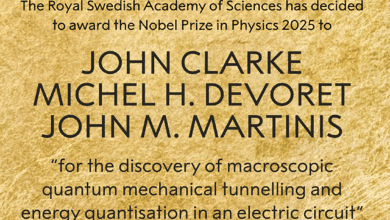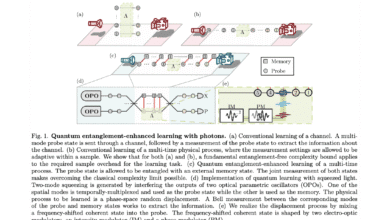Microsoft’s Majorana‑1 Chip Demonstrates X and Z Loop Parity Measurements

Table of Contents
Microsoft’s Azure Quantum team has released a new scientific paper (Distinct Lifetimes for X and Z Loop Measurements in a Majorana Tetron Device) presenting the first experimental evidence of complementary Pauli-X and Pauli-Z parity measurements on a topological qubit. The results, announced by Microsoft Quantum Technical Fellow Chetan Nayak in a LinkedIn update, showcase the ability to “harness a topoconductor … and engineer a topological qubit that is small, fast, and digitally controlled”. In essence, Microsoft’s Majorana-1 quantum chip – unveiled amidst much fanfare (and a bit of controversy) earlier this year – has now demonstrated the two fundamental quantum measurements needed to operate a Majorana-based qubit. This development comes after years of skepticism surrounding Microsoft’s topological qubit approach, and the new data goes a long way toward validating the company’s high-risk, high-reward strategy.
From Hype to Peer-Reviewed Evidence
When Microsoft unveiled Majorana-1 in Feb 2025, it was heralded as the “first quantum processor powered by topological qubits,” likened to inventing a “transistor for the quantum age” with a clear roadmap to 1,000,000 qubits on a hand-sized chip. However, the accompanying scientific paper (published in Nature with over 160 co-authors) painted a more cautious picture. It described an experimental test device for Majorana zero modes, not a fully operational quantum computer. In fact, Nature’s editors explicitly noted that “the results in this manuscript do not represent evidence for the presence of Majorana zero modes in the reported devices”, only a device architecture that “might enable” future Majorana-based experiments. This gap between press-release hype and peer-reviewed evidence raised eyebrows in the quantum community. Many experts, mindful of Microsoft’s past claims, remained unconvinced until concrete proof arrived.
Skepticism was fueled by Microsoft’s track record in this area. In 2018, a Microsoft-affiliated research team claimed to have observed Majorana particles – a sensational result published in Nature – only to have that paper retracted in 2021 after other scientists found inconsistencies in the data. Then in 2022, Microsoft announced it had fabricated Majorana-based qubits in the lab (a “historic milestone” for Azure Quantum) without any peer-reviewed publication to back it up. This pattern of bold announcements lacking solid data made the community understandably cautious. As noted in my February analysis “Microsoft’s Majorana-Based Quantum Chip – Beyond the Hype“, Microsoft’s topological qubit was considered by some as “probably 20–30 years behind” more mature platforms like superconducting circuits or ion traps at that point. In the months following the Majorana-1 unveiling, Microsoft hinted that newer results (not included in the first paper) were forthcoming. Now, with the July 2025 paper and dataset, the Azure Quantum team has delivered the hard evidence many were waiting for.
X-Loop and Z-Loop Parity Measurements in a Tetron Device
The newly released paper demonstrates that Microsoft’s team has built a tetron qubit device (two InAs/Al semiconductor-superconductor nanowires connected by a superconducting backbone) and successfully performed two distinct types of quantum measurements on it. These correspond to the two fundamental Pauli operators for a qubit – the X (bit-flip) and Z (phase) measurements – implemented via fermion parity readouts in different configurations of the device. In practical terms, the researchers can measure the qubit’s state in the Z-basis by checking the parity of electrons on a single nanowire loop, and in the X-basis by checking parity on a loop that spans both nanowires.
How does this work? In a Majorana tetron, four Majorana zero modes encode one qubit. One way to “read” the qubit is to measure the combined quantum state (parity) of the two MZMs on the same nanowire – this constitutes a Pauli-Z measurement of the qubit. Microsoft’s device accomplishes this by coupling the nanowire to a quantum dot sensor, forming a “Z loop” interferometer; the dot’s capacitance shifts depending on whether the nanowire’s electron parity is 0 or 1 (even or odd total electrons), allowing a dispersive measurement of that parity. To measure in the orthogonal basis (Pauli-X), the team instead reads the parity of two MZMs on different nanowires. They create an “X loop” by bridging the two nanowires through the superconducting backbone and quantum dots, so that the parity of this larger loop involves one end of each nanowire. This X-loop parity essentially projects the qubit state onto a superposition basis (|0⟩ ± |1⟩). Together, the Z-loop measurement and X-loop measurement constitute two complementary ways of collapsing the qubit’s state, just like measuring a conventional qubit along the Z or X axis of the Bloch sphere. Crucially, these are projective, single-shot measurements – the team can obtain the qubit parity in one go, rather than averaging repeated trials.
Why is this important? Demonstrating both X and Z parity readouts on the same device means Microsoft has shown the basic ability to fully control and read out a topological qubit’s state. In fact, the paper remarks that this is the first demonstration of two distinct, orthogonal parity measurements in a tetron qubit device, corresponding to Pauli measurements in two bases. These two measurement types are all that is required (at the single-qubit level) for quantum computation and error correction on this platform. In a topological qubit architecture like Microsoft’s, gates and qubit operations would be implemented via sequences of such parity measurements. So achieving both is a key milestone: it shows that the qubit can be both initialized and measured in different bases – a prerequisite for any quantum error-correcting code.
Performance: Parity Lifetimes and Readout Fidelity
With the X and Z loop measurements in hand, the Microsoft team characterized how the qubit behaves in each mode. One striking result is that the parity state lifetimes differed by nearly three orders of magnitude between the two measurement loops. When continuously measuring the qubit’s Z-loop parity, they found that it would hold a consistent value (no parity flips) for an average of τ_Z ≈ 12.4 milliseconds. In contrast, the parity in the X-loop would only remain stable for about τ_X ≈ 14.5 microseconds on average before a random flip occurred. This means the qubit’s state in the Z basis is dramatically more robust than in the X basis – a direct consequence of the topological design. In the tetron, the Z parity corresponds to the intra-wire fermion parity, which enjoys more protection, whereas the X parity involves two wires and is more exposed to disturbances.
The paper attributes these two timescales to different error mechanisms, consistent with theoretical expectations. The Z-parity lifetime (~12 ms) appears to be limited by quasiparticle poisoning – sporadic outside quasiparticles tunneling into the superconducting system and flipping the parity. Such poisoning events are relatively rare at millikelvin temperatures, hence the long dwell times for Z parity. On the other hand, the X-parity quickly randomizes (~14 µs) due to a combination of thermal excitations and any residual coupling (energy splitting) between the nominally degenerate Majorana modes on each nanowire. In simpler terms, the X-basis parity is more fragile: even tiny energy differences or thermal noise can cause the joint parity between two wires to flip frequently (analogous to faster dephasing). The fact that τ_Z >> τ_X is actually expected in a Majorana qubit – it reflects that one type of logical information (the total parity of a wire) is more strongly topologically protected, while the complementary information (the joint parity across wires) is more prone to error. Encouragingly, the measured values (∼10⁻² s vs 10⁻⁵ s) match the ballpark predictions of Microsoft’s theoretical models for a device of this design, indicating no unforeseen decoherence sources are dominating.
Microsoft’s experiment also evaluated the readout fidelity for each measurement loop, i.e. how reliably they can distinguish the two parity outcomes (“0” or “1”) in a single shot. Here too, there was a stark difference between Z and X. The Pauli-Z (Z loop) measurement achieved a 99.5% single-shot fidelity, corresponding to only about 0.5% assignment error. This means the readout is virtually always correct, an extremely high fidelity for any qubit measurement. It underscores the advantage of the topological setup: reading out the parity of one nanowire is a quantum nondemolition measurement that minimally disturbs the qubit and is inherently robust. By contrast, the Pauli-X (X loop) measurement had a ~84% fidelity (~16% chance of misidentifying the parity). This relatively high error rate is not surprising given the X loop’s short lifetime – if the parity flips during the measurement or if the signal-to-noise is low due to the tiny energy split, errors will occur. Notably, the 0.5% vs 16% error rates align with what the researchers expected for the given device parameters. They represent a trade-off: the Z-basis readout is nearly flawless but the state decays slowly, whereas the X-basis readout is faster and more error-prone. In theory, even a 84% reliable X measurement can be usable for quantum error correction (with repetition or cross-checks), but it will need improvement. The team identified several engineering paths to reduce the X error rate, such as better isolating the Majorana modes to eliminate residual coupling, and filtering out external noise. Overall, the data shows that both parity measurements are working within the expected regime of a Majorana qubit hardware model, providing confidence that no unknown physics is spoiling the qubit’s behavior.
Implications for Topological Qubits and Microsoft’s Quantum Strategy
Demonstrating X and Z loop measurements in one device is a major proof-of-concept for Microsoft’s topological qubit program. It closes the loop (no pun intended) on the basic qubit operations: the Majorana-1 chip can now initialize, measure, and (by extension) perform single-qubit gates via parity measurements. In fact, measurement-based schemes only require Pauli X and Z measurements (plus the ability to prepare certain states) to enact a form of quantum computation. Microsoft’s team emphasized that these are the only single-qubit operations needed to do quantum error correction on a topological qubit. Thus, the experiment effectively shows that their device “behaves fully as a qubit” in the operational sense. This goes a long way to validate the claims made during the Majorana-1 unveiling. Whereas earlier this year skeptics pointed out that Microsoft had not published evidence of even a single working topological qubit, now we have peer-reviewed results showing a qubit encoded by Majorana modes with measurable state stability and quantum behavior. It’s an important credibility boost for Microsoft: the data confirms that Majorana zero modes are indeed present and controllable in their device (manifesting as the two parity eigenstates), something that had remained unproven and contentious until now.
That said, Microsoft is not declaring victory or quantum supremacy just yet – the results are a first step toward a fault-tolerant topological qubit, not the end goal. The 12.4 ms vs 14.5 µs lifetime disparity highlights that there is still significant work to do to fully leverage topological protection. The Z-loop parity is long-lived (comparable to some of the best conventional qubits’ coherence times, which is remarkable), but the X-loop parity must be improved by roughly three orders of magnitude to be competitive as a qubit on its own. In practice, error correction will have to bridge that gap by repeatedly stabilizing the X basis. The team’s next planned milestone is to perform back-to-back X and Z measurements in rapid succession to confirm that the qubit can be rotated and measured arbitrarily without losing coherence. This would establish the orthogonality of the two parity basis measurements and demonstrate basic single-qubit gate functionality. (For example, an X measurement immediately following a Z measurement should yield random 50/50 outcomes if the qubit was initially in a Z eigenstate – a test of proper superposition.) Achieving that will likely require some hardware refinements to perform the measurements faster than the ~µs decoherence time on the X loop. Additionally, scaling up to multiple qubits will introduce new challenges of cross-talk and maintaining uniform topological phases across a larger array. Microsoft’s roadmap calls for integrating arrays of tetron qubits and implementing a tailored error-correcting code (the Hastings-Haah “Floquet code”) on them. The current experiment strengthens confidence that such a roadmap is feasible: it shows that the building blocks – stable Majorana modes and parity readouts – are technologically realizable.
Topological Qubits vs. Competing Architectures
Microsoft’s approach with Majorana-based qubits is notably different from the quantum computing architectures pursued by other industry leaders like IBM, Google, and Quantinuum. IBM and Google have been advancing superconducting qubit platforms (transmon qubits) and focusing on improving gate fidelities, coherence times, and error correction through clever engineering. For instance, IBM’s latest 156-qubit Heron R2 chip uses a heavy-hexagonal qubit layout with tunable couplers and other innovations to suppress noise, allowing circuits with thousands of operations to run reliably. Google’s recent “Willow” demonstrated that adding more qubits in a surface code can actually reduce error rates exponentially, hitting a key threshold for logical qubit improvement. These efforts, however, still rely on brute-force error correction with a large overhead (many physical qubits per logical qubit) and incremental hardware refinements.
Quantinuum (Honeywell), on the other hand, champions trapped-ion qubits, which are a very different modality. Ion trap qubits (e.g. ytterbium or barium ions) have the advantage of excellent coherence and fidelity – ion qubits can stay coherent for seconds and achieve gate fidelities above 99.9%, far better individual performance than today’s solid-state qubits. Quantinuum has demonstrated high-fidelity logic and even small error-corrected codes on its ion processors. The downside is that trapped ions are slower (gate times in the tens of microseconds or more) and harder to scale in parallel – the approach may require innovative engineering like shuttling ions or photonic interconnects to reach millions of qubits. Overall, these conventional platforms are currently far more mature than Microsoft’s topological hardware. It’s telling that earlier this year, before Microsoft released its new data, experts estimated that topological qubit technology was “20–30 years behind” superconducting and ion-trap qubits in practical development. In other words, Microsoft’s qubit in early 2025 was roughly where mainstream qubits were a couple of decades ago – a scientific curiosity, not yet a competitive computing element.
The promise of the topological approach, and why Microsoft has invested heavily in it, is the potential to leapfrog the conventional architectures in the long term. If Majorana qubits can be made to work as envisioned, they could encode information in a fundamentally more robust way, intrinsically suppressing certain errors without the need for thousands of physical qubits to correct them. For example, Microsoft projects that a million physical Majorana qubits might yield on the order of 1,000 logical qubits – a 1,000:1 overhead – whereas a million superconducting transmons (with surface code) would give only a handful of logical qubits (an overhead in the tens or hundreds of thousands to one). This huge gap is why Microsoft’s strategy is often described as a moonshot: hard to realize, but potentially revolutionary if successful. With the new parity measurement results, Microsoft can now point to tangible progress supporting this vision. They’ve shown that the exotic Majorana physics can be tamed to perform real qubit operations, bolstering their case that topological qubits are not just a theoretical fantasy. Of course, competitors are not standing still – superconducting and ion-trap systems are also improving, and other novel approaches (like AWS’s bosonic cat qubits or PsiQuantum’s photonic qubits) are in the mix.
Microsoft, now armed with a working prototype, still faces the daunting task of scaling from an 8-qubit test chip to a full-blown fault-tolerant machine. The coming few years will be critical to see if the Majorana approach can overcome its engineering challenges faster than the conventional technologies can brute-force theirs. For now, Microsoft has achieved an experimental breakthrough that puts it firmly on the map in the quantum hardware race – turning some of the Majorana skepticism into cautious optimism.
Quantum Upside & Quantum Risk - Handled
My company - Applied Quantum - helps governments, enterprises, and investors prepare for both the upside and the risk of quantum technologies. We deliver concise board and investor briefings; demystify quantum computing, sensing, and communications; craft national and corporate strategies to capture advantage; and turn plans into delivery. We help you mitigate the cquantum risk by executing crypto‑inventory, crypto‑agility implementation, PQC migration, and broader defenses against the quantum threat. We run vendor due diligence, proof‑of‑value pilots, standards and policy alignment, workforce training, and procurement support, then oversee implementation across your organization. Contact me if you want help.



